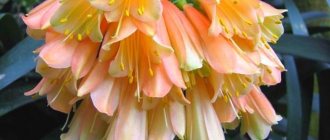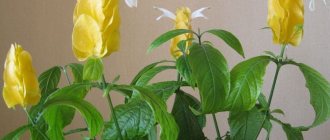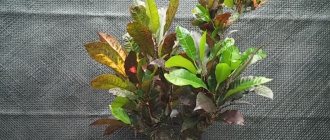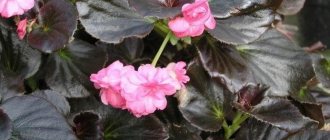The beautiful clematis flower has several other names, such as clematis, lozinka. This is a representative of the Ranunculaceae.
A perennial plant common in the subtropics of the Northern Hemisphere. There are approximately 300 species.
General information about clematis
Among the numerous representatives of clematis there are subshrubs, shrubs, and herbaceous plants, although the majority are represented by a group of vines.
All species have one of two types of root systems: taproot and fibrous. Flower shoots can develop from above-ground buds or from the underground part. The leaves can be simple or compound, usually green, sometimes purple.
Simple forms of clematis are represented by a flower filled with stamens and pistils, making the plant resemble a spider.
The shade range of the plant is varied - from pale pink to rich red, from sky blue to deep blue, as well as snow-white and yellowish inflorescences.
Varieties of varieties
There are different classifications of lozinki. Fans classify them by flower size: small-, medium- and large-flowered plants. But according to the international division, clematis varieties look like this:
- Group “A” – plants that bloom on the shoots of the previous season (Alpina, Florida, Montana).
- Group “B” – fresh and last year’s shoots bloom (Lanuginosa, Patens).
- Group “C” – forming flowers on shoots of the current period (Jacman, Vititsella, Integrifolia).
Classification and description
Clematis (photo) can be small-flowered or large-flowered, climbing or bushy. There is a classification of crop types with different numbers of sections and subsections, in accordance with similar morphological characteristics. It is more convenient for gardeners to use the classification of hybrid plants, which takes into account the origin of the maternal line.
Large-flowered climbing varieties and forms of clematis are included in the group of Patens, Vititsella, Jacqueman, Lanuginosa and others, large-flowered bush varieties are included in the Integrifolia group. But now, due to the intensive development of selection, the classification has practically lost its original purpose. Now the boundaries between groups are blurred due to the inheritance of characteristics and quality of not only maternal, but also paternal forms by many hybrids. Varieties of certain groups are obtained from crossing maternal forms with clematis of other varieties, forms and species.
Let's take a closer look at the clematis varieties (photo) and description:
- Jacquemin's group
Large shrubby plants have:
- length – 3-4 m;
- well developed root system;
- complex pinnate leaves consisting of 3-5 large leaves;
- single elongated buds or collected in groups of 3;
- large flowers, their d = 8-15-20 cm when opened, the buds are directed to the side and upward;
- a simple perianth consisting of 4-6 sepals in blue, violet and purple colors.
Buds form on the branches of the current year; they bloom profusely and for a long time throughout the summer month. By winter, they are cut off, leaving 2-3 pairs of buds at the base above the soil level.
The most popular varieties of the Jacqueman group:
Comtesse de Bouchaud (Comtesse Debouchaud). The shoots of the shrub crop are 2-3 m long and brown in color. The complex imparipinnate leaves, composed of 5 ovate leaves, have dense, pointed plates. The buds are pointed-elliptical in shape, they are directed upward. Long peduncles - up to 18 cm - hold open flowers in the form of a cup, d = 10-16 cm. There are 6 pink or violet-pink sepals with purple veins, they have a pointed elliptical shape and slightly wavy edges. The anthers are colored cream (light yellow). There is an abundance of flowers on the plant in July-August; buds form on the shoots of the current season, some of which bear one seed. The variety is used for vertical gardening and pruned in winter.
William Kennett (William Kennett). An old English variety, the length of its shoots is 3-4 m. It is distinguished by large simple leaves, open flowers, d = 15-18 cm. The petals on young flowers have a wavy edge. Wide sepals of blue color with pink spots, and there are 6-8 of them, overlap each other. The anthers are colored dark red.
Voluceau (Volusi). On a vine 2.5-3 m long, large flowers appear in dark lilac-red tones with a red stripe on the petals and contrasting yellow anthers. Their diameter is 12-15 cm, flowering phase is July-September. The crop belongs to the third group of pruning.
Bella (Bella). On shoots of vines up to 1.5-2 m in length, star-shaped buds with 6 petals and dense waxy sepals look impressive. Initially they have d = 10-15 cm, the petals are pale yellow, then white. It is resistant to cold climates and fungi. Flowering phase – July-September. Classified as pruning group 2.
Hagley Hybrid (Hagley Hybrid). The shrub crop (up to 2.5 m) is decorated with complex leaves, consisting of leaves with a whole or lobed, pointed-ovate plate. The buds are somewhat elongated and directed upward. Long peduncles hold flowers with a diameter of 12-16-18 cm, with six pointed elliptical sepals. They have wavy edges and a pinkish, pearlescent or lilac-pinkish tint. The anthers have a purplish-burgundy or dark red-purple tone. An abundance of color occurs in the third ten days of June and August on the shoots of the current season. Some of them set single seeds. The branches should be pruned by winter; they will grow back quickly in the new season. The culture is resistant to fungi and low temperatures. Can be planted on balconies, loggias, in a group with other flowering plants and one bush at a time.
C. x jackmanii Th. Moore (Jackmany, Jacquemant). The long, up to 3-4 m, shrub plant has dark brown young branches, there can be 10 of them. They are decorated with complex leaves, consisting of 3-5 small leaves with ovate or oblong-ovate dense plates. They can get sunburned in direct sunlight. The buds are oblong-ovoid in shape and are drooping or directed to the side. At the ends of long peduncles, single buds or a group of three bloom, their d = 10-15 cm. They are distinguished by diamond-shaped sepals of a dark violet (purple) color, turning into blue-violet. There are 4-5 or 6 of them and they fade in the sun. The yellowish anthers have a light brownish groove. An abundance of opening buds (30-90 each) occurs on the shoots of the current season in July-September. They are cut off for the winter. Occasionally, single seeds can be found.
Roko (Roko). When opened, the buds have a diameter of 12-16 cm, sepals (4-6 pieces) of a dark purple tone with wavy edges overlap each other and are raised upward. The anthers are light in color. On a shrubby vine up to 1.5-2 m in height, trifoliate leaves and flowering buds appear on the branches of the current year. The flowering phase is long, lasting July-August, until the first frost. The plant tolerates the climate of the central and northwestern regions of the country.
Gipsy Queen (Gypsy Queen). The shrub plant has 10-15 shoots, they are 2.5-3.5 m long. Compound leaves have 5 leaves with whole or lobed blades of a pointed ovoid shape. They fade under the sun. The upward-directed flowers are open, their d = 11-15 cm. Wide velvety sepals (4-5-6 of them) have an obovate shape of a dark purple-violet color, somewhat fading under the rays of the sun. Large anthers have a dark purple and purple tone, and the pollen is also colored. This year, the shoots are decorated with flowers (18-20 on each) from July until autumn frosts. The variety is resistant to frost and fungal diseases.
Roko-Kolla (Roko-Kolla). In open star-shaped flowers:
- d = 150 - 180 mm;
- 6 sepals are white and have a pale yellow-green central stripe;
- yellow anthers.
Shrub vines, 2 m long, have beautiful trifoliate leaves and flowering buds on the branches of the current season, which are pleasing to the eye from July to October.
2. Patence group
The group includes shrub plants, 3-3.5 m long with thin young branches, pinnately compound leaves consisting of 3-5 leaves, open single flowers, 15 or more cm in diameter, star-shaped and other shapes, 6-8 sepals . Single or double buds come in a variety of colors: light or bright blue-violet, thick violet-blue or purple. All this beauty appears on last year's shoots, and occasionally re-blooming occurs on the shoots of this year. For the winter, they need to be covered after shortening and removing dry parts of the plant.
Let's look at the most popular varieties of the Patens group:
Andromeda (Andromeda). Clematis Andromeda has trunks that reach a length of 2-4 meters; the variety is a moderately growing crop. The creamy pink buds have a crimson-purple stripe on the sepals and yellow anthers. Overwintered branches are covered with semi-double flowers up to 15-20 cm in diameter and delight the eye in June and again in August. The liana belongs to pruning group 2. The culture prefers cool and not very sunny corners. It climbs well over trellises, nets, garden supports, coniferous or deciduous shrubs.
Barbara Dibley (Barbara Dibley). On the shoots of the current season of shrub vines up to 2-2.5 m, trifoliate leaves appear, the leaves of which have pointed-ovate or oblong-ovate plates. The erect buds are oblong-ovoid in shape and point upward. During flowering, they are open, have a star-shaped shape, their d = 15-18 cm. The 6-8 elongated-pointed sepals have wavy edges, a pink-lilac color and a purple-crimson central stripe. They fade under direct ultraviolet light. The anthers have a red-purple tone. Abundant flowering appears on last year's shoots, and again this season. The seeds are set. Resistance to frost and fungal diseases is shown.
Barbara Jackman (Barbara Jackman). On shrubs up to 2-2.5 m in height, the leaves can be simple or trifoliate, the leaf blades can be entire or lobed, pointed-ovate in shape. The open pointed-ovate flowering buds, directed upward, d = 12-18 cm, have sepals (6 pieces) of a pointed elliptical shape overlapping each other. Their color can be lilac-pink with a lilac-pink with a plum tint or a red-purple stripe running down the center. The anthers have a cream (light yellow) tone. Last year's branches bloom in May-June, and beauty appears on them again this year.
Bees Jubilee (Biz Jubilee). On the 2-3 meter trunks of last year, clusters of large disc-shaped flowers appear in the upper part, their d = 15-18 cm. The light purple sepals (6-8 of them) have a red-purple stripe running down the center. The leaves can be simple or trifoliate, pointed-ovate in shape and have a notched base. The flowering phase is June on the shoots of the previous year, the second time - in July-August before frost - on the shoots of the current season.
Doctor Ruppel (clematis Doctor Ruppel, photo and description of an extra-class variety). The branches with trifoliate leaves reach a length of 2-2.3 m, and the flowers are 15-20 cm in diameter, have a carmine pink color and a bright crimson stripe, the anthers are beige in tone, and there are 6-8 sepals. All this unusual beauty gives the plant a decorative appearance. It is characterized by sufficient winter hardiness and disease resistance. Last year's moderately growing branches bloom in May-June, new ones - in August-September. Prefers cool corners where there is no direct ultraviolet radiation. It actively climbs along fences, walls, gazebos, trellises, trees and shrubs.
Cassiopeja (Cassiopeia). The disc-shaped flowering buds have d = 14-18 cm, the color is pale purple, then white, with wavy edges with teeth. Last year's branches, up to 2 m long, bloom in early June, this year - in the last ten days of July. The culture has average shoot-forming ability, resistance to low temperatures and fungal diseases.
The President (President). A shrub plant up to 2-2.5 m has 7-10 young branches. The leaves on them can be simple or trifoliate with entire or lobed plates on oblong-ovate leaves. In the southern regions, chlorosis often appears on them. Long peduncles hold open flowers that look upward, their d = 14-18 cm. On 6-8 dense purple-violet or dark blue-purple pointed oblong-elliptical sepals with curved edges, the central stripe is lighter. The anthers have a dark reddish-purple tone. All this beauty fades slightly in direct sunlight. Last season's branches bloom profusely in May-June, this season's - in July-August. Ovaries with single seeds may appear.
Souvenir du Capitaine Thuilleaux , Capitaine Thuilleaux (Captain Thuilleaux). Last year's shoots are up to 2-2.5 m in late spring - early summer and are covered with large pale pink flowers up to 15-20 cm with a large bright pink stripe in the center of the petals. Repeated flowering occurs on the shoots of the current year in August-September. By winter, branches should be removed from their supports and protected from frost. Hot and highly lit places are not suitable for culture. It is best planted next to small shrubs or in containers.
3. Viticella violet group
The group consists of shrubby vines growing up to 3-3.5 m. The compound leaves have 5-7 double pinnate leaves. In drooping buds, the open petals are directed to the side or upward. Also collected are 3 single, somewhat drooping buds, when opened they have d = 12 or more centimeters, 5-6 sepals, colored pink-purple tones. Plants of this group bloom profusely and for a long time on the shoots of the current season, covered with hundreds of buds. Single seeds may set.
Etoile Violette (Etoile Violette). On a trunk 4-6 m long, the shoots of the current year are early covered with open flowers, 10 cm in diameter with ends bent back, purple-lilac in color. Flowering phase – July-September. The crop has average frost resistance; without shelter it can survive at a temperature of 20° below zero.
Victoria (Victoria). A shrubby large-flowered crop up to 2.5-3-4 m has up to 20 shoots in a bush. Compound leaves have 3-5 leaves with a solid, less often lobed, dense plate of a rounded-ovate shape. The buds are drooping, looking down or to the side. The diameter of the open flowers is 10-15 cm, they are held in place by long peduncles. Wide sepals intersecting each other, 4-5-6 of them, obovate in shape, have a wrinkled texture and a purple-pinkish-lilac color that fades in the sun. The contrast is created by the yellowish anthers. During flowering in July-September, single seeds are set. Before winter, shoots should be pruned.
Viola (Viola). On young branches up to 2.5 m with trifoliate or odd-pinnate leaves this year, disc-shaped, propeller-shaped, open flowers appear in July-October, their d = 10-14 cm. The obovate sepals (6 of them) have the edges of an elongated pointed apex raised upward, there are veins of a dark purple color with purple. The anthers are light yellow in color.
Ville de Lyon (Ville de Lyon). A very beautiful and popular shrub plant among gardeners, it reaches a length of up to 3.5 m. It has up to 15 dark brown trunks. Compound leaves consist of 3-5 entire or lobed leaves with a dense, pointed-ovate plate. In the heat, at the base of the shoots they turn yellow and dry out. The open buds are directed upward, their d = 10-15 cm, held on long peduncles. There are 6 wide, overlapping sepals, they are obovate in shape, carmine-red in color, darker at the edges, they fade under the sun. The color of the anthers is bright yellow or yellow. Up to 10-15 flowers appear on the branches of the current season during the summer; single seeds may set. They should be pruned by winter. Shows average resistance to frost and fungal diseases; in the southern regions it is affected by powdery mildew.
4. Lanuginosis woolly group
The group includes shrubs with long trunks up to 2-3 m, a well-developed root system, and green mass with an edge. The blades of entire, simple or trifoliate leaves burn under direct sun. The buds are single and they go upward, open wide, their diameter is 16-20 cm. The sepals, 6-8 of them, are light in color: white, blue, pink. Abundant flowering appears on last season's shoots. Many flower buds are formed in autumn. The crop blooms again this year on growth in the second half of July and delights those around throughout August. The plant can be propagated by seeds. Drought and overheating of the soil negatively affect the plant.
Emajogi is a prominent representative of this group. Planted as a single plant or in a group with others, for vertical gardening. The trunks of the current year are covered with open flowers, 16-18 cm in diameter, with light purple-blue sepals, 6-7 of them, and pale yellow anthers.
5. Florida Group
The group includes shrub species of double varieties of various colors; the perianths can be two-colored. They emit a subtle aroma. The branches of the last season bloom in May-June, the second time - in this season - in July-August. By winter, they are shortened to a length of 1.5-2 m and stored under cover.
Daniel Deronda (Daniel Deronda) reaches a length of 1.5-2-3.5 m, overgrown with trifoliate or simple leaves. The leaf blade is elongated-ovate, the petioles with young leaves are purple in color. The buds are lanceolate-shaped, standing, the open semi-double or double flowers are star-shaped, the sepals, there are 6-8 and even 66 of them, have a pointed elliptical shape, a thick violet-blue color and a lighter center. The anthers have a green-yellow tone. Propagated by seeds.
Jeanne d'Arc (Jeanne D'Arc). Disc-shaped flowers have d = 12-20 cm, sepals (6-8-24) have a white tone. The vines reach a length of 2.5-3 m. Flowers cover last year's shoots.
C. x jackmanii Alba (Jacman Alba). The diameter of the disc-shaped flowers is 11-14 cm, the white sepals (4-6-19-27) have light purple veins. Last year's shoots bloom in the second half of June, young ones - from the second half of July to the end of August. The liana reaches a length of 2-2.5 m.
It is impossible to talk about all the groups and the varieties included in them in one article. But we cannot fail to note the following clematis:
- Alyonushka (photo and description). Clematis (Inegrifolia) Aljonushka is planted closer to home; the perennial will delight its owners with many dark pink bells in June-September. Vertically raised branches need to be secured to a support, but the plant can carpet the ground in unsightly places. Containers with it or flowerpots can be installed on balconies. Prefers both sunny and semi-shaded locations. A young plant has 3-4 roots.
- Clematis asao ( Asao ) Japanese selection. On a shrub vine up to 2-3 m during spring to early summer, semi-double or simple open flowers appear, 12-20 cm in diameter with dark pink sepals (6-8 of them). They have a pale central stripe, and the anthers are yellow in color. Overwintered shoots bloom for the first time, and young shoots bloom for the second time in the second half of summer. Hot and sunny corners are not suitable for the crop; they are planted next to walls, fences, trellises, gazebos, and natural supports: trees and shrubs. Can be grown in containers.
- Clematis blue angel ( Blue Angel). The name indicates the color of large buds, 10-15 cm in size. The liana reaches a size of 3-4 m, blooms late, but continuously from July to September, loves light, and is frost-resistant. The sepals have wavy edges and a groove in the center; in the center of the star, stamens of a soft yellow tone are visible.
- Clematis Josephine. It has large, delicate pomp-shaped lilac-pink flowers, with a burgundy lobe stripe running through the center of the petals. Last year's branches begin to decorate in early June, and both last year's and young shoots will bloom for the second time in early September. They cling well to supports, and you can plant bushes between conifers and roses.
- Clematis Chania (photo and description). Hania or simply Hania is a hybrid of Polish selection. The shrub has a trunk length of 2-2.5 m, magnificent large, two-colored velvety flowers, their d = 15 cm. They have sparkling red petals (6 of them), 7 cm long and 3.5 cm wide, they are pink border, and contrasting golden stamens are located in the center. In early spring, trunks should be cut from the base to 150 cm. It climbs well over supports.
- Clematis Sunset . A perennial large-flowered hybrid plant reaching 3 meters in length. Dark green small foliage appears on a strong flexible stem, flowers up to 15 cm in diameter bloom twice a year: on the stems of last year's season - in early summer, on young shoots - in early autumn. Inside the deep pink sepals with a bright purple stripe in the center, golden stamens are visible. Autumn pruning should be carried out, leaving 50-100 cm on the shoots and covering the plant in winters with little snow.
- Clematis mefistofel ( Mefistofel) grows up to 300-400 cm, purple flowers have a diameter of 10-14 cm. It loves moisture and light, sunny areas, can curl along supports or create a carpet on the soil surface. Before winter you need to prune heavily.
- Clematis purpurea Plena elegans (photo). Purpurea Plena Elegans is a terry variety of French selection. It is lushly covered with medium-sized buds, similar to curly roses, d = 5-10 cm, without stamens. A climbing plant, 3.5-4 m high, prefers sunny areas and withstands temporary drought. The terry petals are colored in a complex burgundy-lilac tone. Flowering phase – June – mid-September. For winter, prune and leave a height of 50 cm.
- Wild clematis (photo). Small-flowered vines are called wild hops. They have undeservedly lost popularity, despite the abundance of flowers and winter hardiness. The advantage of the culture is that vines of all varieties are covered with flowers in the current season, which simplifies pruning shoots for winter . The diameter of the buds is up to 5 cm. More often you can find bushes of the following varieties: Alpine bluish-violet up to 3 m in length, Pamela Jackman blue-violet - up to 5 m, Siberian snow-white - up to 3 m.
Classification by categories and methods of pruning plants
Based on the description above, there are three groups or categories of vines that need to be properly pruned. Namely:
Group I. Last year's shoots lay buds and bloom in early June with luxurious, fashionable and amazing inflorescences; shoots are not cut off for winter or spring; they must be covered for winter. The group includes varieties such as Alpina, Montana and Macropetala. To make the bushes look beautiful and neat, weak, damaged and not prone to development branches are removed from the crown.
Group II. Last year's and new branches are covered with flowering buds; in double varieties, only last year's ones are covered. Young shoots are covered with simple-shaped inflorescences. The first wave of flowering is May - early June, the second - July-August and September until the first frost. This includes, for example, hybrids from Lanuginosa, Florida and Patence.
For plants with a two-stage flowering pattern, remove excess branches from the bush. Prune shoots after flowering:
- last year - after the first stage in the summer;
- of the current season - in the fall.
In bushes such as the President variety, shoots are shortened by a quarter to obtain early flowering.
Group III. Only young shoots bloom. Simple pruning is carried out in early spring and autumn; it is not needed in summer. Keep 2-3 nodes on each shoot, their height should remain approximately 50 cm above the soil surface. If there are many buds left, the plant will bloom intensively, if there are few buds, then there will be few buds, but they will be large. For the winter, they are cut off at the root, leaving 2-3 pairs of buds, and not covered. The group includes vines from the Jacquemman family, such as Integrifolia and Viticella.
Growing weeds
There are several ways to grow this plant.
From seeds - here they are divided into groups, which is influenced by the size of the seed and the duration of the germination period:
- Instances with large seed sizes that take quite a long time and do not always germinate evenly:
- Clematis with medium seeds;
- Plants with small seeds that germinate quickly (from 2 weeks to 4 months)
If the seeds were collected in the current period, then they will germinate much better.
Small seeds are sown in March-April, medium-sized ones - after the long New Year holidays, large ones - at the end of the fresh harvest in the autumn-winter period.
First, the seeds are soaked in water for 10 days, then the seeds are laid on a substrate of soil, pitch and peat and sprinkled with a layer of sand, covered with a glass plane. Temperature for germination is from 25 to 30 Celsius.
Plant seedlings must be protected from direct sunlight. When the first full-fledged leaves form, the plants are cropped into independent containers.
When truly warm spring days arrive without frost, clematis is planted in the soil at intervals of at least 20 cm.
Features of planting, transplanting and propagation
It is preferable to plant sprouts obtained as a result of rooting cuttings. It can be propagated by grafting, layering and dividing bushes. Seedlings can also be purchased at company stores.
It is important to know. It is impossible to identify bushes in deep partial shade and shade, in drafts, in lowlands with close groundwater, directly under walls and buildings where rainwater flows.
When planting in spring:
- A seedling from the store is immediately placed in the ground for growing , and after 2 years it is transplanted to a permanent place of residence.
- In a low area, a mound of soil is made for the plant, and soil with humus and ash are added to the planting hole.
- The root collar is deepened by 3-8 cm, depending on what stage of development the plant is at in the spring. After this, the bushes are watered and the soil under them is mulched.
- The interval between bushes is up to 1.5 m, depending on the variety.
- The vines are provided with support and tied up.
If clematis has a closed root system, then planting is carried out throughout the season, from spring to late autumn. If plants were purchased in winter or early spring, they are placed temporarily in a greenhouse or on window sills.
If the root system of the purchased plants is open, then the favorable time for planting is April - early May. At this time, the buds are just swelling, but not yet starting to grow.
Important. In spring, you should not miss the planting date, since the plant begins its growing season early. Late planting disrupts the rhythm of life of the vine, so in the first season the seedlings take root worse and do not gain enough strength to overwinter.
If seedlings are grown indoors, they are planted in the ground later due to the threat of return frosts in the spring. When planting in the fall, choose the end of August - beginning of October, so that the bushes have time to take root if the air temperature is optimal. Lianas are insulated for the winter with dry fallen leaves, and on top - with covering material, for example, lutrasil.
Planting pits are prepared in advance:
- make the following hole sizes - 60x60x60 for individual bushes, for several - a trench, the depth and width of which will be 60 cm;
- Lay drainage on the bottom with a 10-15 cm layer of broken brick, crushed stone or expanded clay.
Nutritious, structural, breathable, alkaline soil where the groundwater level is low is suitable for the culture. A quarter of the selected soil is poured into the hole, mixing it with rotted manure or humus, peat and sand in equal parts by weight. Humus, peat and sand are added to loam, and humus, black soil and peat are added to sandy soil. To any ready-made soil mixture add 1 liter jar of ash, 100 g of complex mineral fertilizer. If the soil is acidic, then add hydrated lime - 50-100 g.
Caring for clematis
Clematis requires regular watering in its planting and care. Plants should be watered as usual once a week. In hot weather - up to three times in 7 days. Up to 20 liters are poured into a young seedling, and up to 40 liters into a mature one. at a time.
Fertilizing of plants is carried out during the period of active growth with nitrogen fertilizers, during budding - with potassium compounds, as soon as the flowers have bloomed - with phosphorus.
Every year in spring, clematis needs to be fertilized with a mixture of chalk and dolomite flour.
The most popular varieties of clematis of different types
Clematis texensis (C. texensis) 'Buckland Beauty'
Plant height 200 - 220 cm . The flowering period is quite long: clematis blooms in July and blooms until September. grows up to 2.2 m in height. Bell-shaped flowers come in two colors.
Cutting the vine
Clematis pruning is carried out both at the growth stage and in winter. In the first A-group of clematis, only weak shoots are pruned. This is best done after flowering has finished, around June.
Pruning of the B-group is carried out at a distance of up to one meter, preserving from 2 to 5 pairs of young buds, removing weak shoots.
In the C-group, pruning is carried out in several stages during the growing season.
After flowering, clematis must be prepared for wintering. To do this, the neck should be covered with a solution of 2% copper sulfate, a bucket of humus should be poured under the root and hilled up to a height of 15 cm.
Dry leaves are poured on top of the plant and covered with a wooden box, covering it on top with protective material in the form of roofing felt, roofing felt or another. To prevent it from being blown away, a brick or layer of earth is placed on top.
Photos of clematis flowers show that for proper growth and an attractive appearance, this plant needs to be supported. It can be designed in the form of arches, fans, pyramids.
To do this, it is worth selecting durable materials, since an adult clematis plant has a large mass.
Lanuginosa group (Lanuginosa)
These clematis are shrubby vines. The shoots grow up to three meters in length. They delight the eye twice a year: in the spring flowers bloom on last year’s stems, and in the summer on fresh ones. The group is distinguished by large buds reaching 15–20 cm in diameter.
The Anna German variety is distinguished by abundant flowering. Buds with a diameter of 15 cm appear in the third year of planting.
In clematis of the Flower Ball variety, the largest number of buds appear on last year's shoots, so they should not be cut off. The bush does not grow higher than 2 meters.
The Ballerina variety will delight you with flowers from July to September; their diameter reaches 15 cm. It is imperative to preserve last year’s shoots.
The Ideal variety fully lives up to its name. Clematis blooms all summer, the buds are large, the plant itself does not need annual pruning, and winters well.
The Lavsoniana variety is good for its abundant flowering twice a season and large buds - up to 23 cm in diameter. The liana grows up to 5 meters in length and requires pruning.
The peculiarity of the Nadezhda variety is that it blooms very profusely twice a season, even with complete annual pruning.
The Chaika variety is small-flowered, up to 13 cm in diameter, but there are a lot of buds on the bush. Clematis remains decorative from spring until the end of September.











